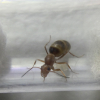- Formiculture.com
- Forums
- Gallery
- Members
- Member Map
- Chat

2nd Opinion Please
Started By
WanderingWill
, Aug 8 2022 8:25 AM
4 replies to this topic
#1
 Offline
-
Posted August 8 2022 - 8:25 AM
Offline
-
Posted August 8 2022 - 8:25 AM
Hey y’all,
Not the most experienced ant keeper, but enough basics.
I recently caught a C. Floridanus queen a couple weeks ago and she’s laid 5 eggs. I checked once and am trying to not check her anymore except in the dark with a red flashlight, and still fear it’s too much of a disturbance so I’m just not going to peek anymore.
My question: Are 5 eggs enough by this point in time?
She was found when my fiancé moved a pot. I’m worried she had started a claustral cell but then was disturbed.
Or, this species starts off slow.
Thanks for your time!
Not the most experienced ant keeper, but enough basics.
I recently caught a C. Floridanus queen a couple weeks ago and she’s laid 5 eggs. I checked once and am trying to not check her anymore except in the dark with a red flashlight, and still fear it’s too much of a disturbance so I’m just not going to peek anymore.
My question: Are 5 eggs enough by this point in time?
She was found when my fiancé moved a pot. I’m worried she had started a claustral cell but then was disturbed.
Or, this species starts off slow.
Thanks for your time!
#2
 Offline
-
Posted August 8 2022 - 8:32 AM
Offline
-
Posted August 8 2022 - 8:32 AM
Hey y’all,
Not the most experienced ant keeper, but enough basics.
I recently caught a C. Floridanus queen a couple weeks ago and she’s laid 5 eggs. I checked once and am trying to not check her anymore except in the dark with a red flashlight, and still fear it’s too much of a disturbance so I’m just not going to peek anymore.
My question: Are 5 eggs enough by this point in time?
She was found when my fiancé moved a pot. I’m worried she had started a claustral cell but then was disturbed.
Or, this species starts off slow.
Thanks for your time!
As a keeper of Floridanus, they do not start off slow, it just takes some time sometimes to lay the first batch. Some queens do all overnight, while others do one a day. If you ever catch another, you can leave it in light as these have no effect of light and can be raised in light without brood. They can see red light, but it doesn’t effect them as much as bright lights do.
Edited by FloridaAnts, August 8 2022 - 8:34 AM.
#3
 Offline
-
Posted August 8 2022 - 8:36 AM
Offline
-
Posted August 8 2022 - 8:36 AM
5 is less than some would have laid, but then again, some queens are bigger layers than others. Your idea that she'd already laid some eggs elsewhere is certainly plausible. Anyway, you have the right idea; just leave her be as much as possible. Unless she expended ALL of her resources laying a previous batch of brood that was left behind when you captured her, she should be able to raise a few nanitics just fine, and they'll take it from there.
- AntsCali098 likes this
#4
 Offline
-
Posted August 8 2022 - 8:42 AM
Offline
-
Posted August 8 2022 - 8:42 AM
No two ants are the same. It would be easier to know how well your one particular queen is doing when you found a lot of them but when you just have 1, its hard to gauge how "well" a queen is doing.
Edited by aznphenom, August 8 2022 - 8:42 AM.
Keeps: Camponotus, Tetra
Wants (Please reach out if you have them for sale if you’re in the US): Acromyrmex Sp., Atta Sp., Cephalotes Sp., Myrmecocystus Sp (Prefer Mexicanus), Odontomachus Sp. (Prefer Desertorum), Pachycondyla Sp., Pheidole Sp (Prefer Rhea. The bigger the better. Not the tiny bicarinata), Pogonomyrmex Sp (Prefer Badius)., Pseudomyrmex Sp. (Prefer the cute yellow ones)
#5
 Offline
-
Posted August 8 2022 - 8:48 AM
Offline
-
Posted August 8 2022 - 8:48 AM
I try not to put my Camponotus in the light because when ever I do it stresses the out. However I’ve noticed that my C. sansabeanus are MUCH more sensitive to light then my C. modoc. When I take my modoc out of the dark they usually just sit there with a couple workers running around but the queen doesn’t care much. While when I take my out my C. sansabeanus the queen starts running all over the test tube trying to get out, and the workers frantically grab the brood. So really I think that light sensitivity varies from species to species.
- AntsCali098 likes this
I keep: C. modoc, C. sansabeanus ![]() , C. maritimus, Formica argentea, M. mexicanus
, C. maritimus, Formica argentea, M. mexicanus ![]() , Odontomachus brunneus
, Odontomachus brunneus ![]() , Pogonomyrmex californicus, Pogonomyrmex rugosus,
, Pogonomyrmex californicus, Pogonomyrmex rugosus,
1 user(s) are reading this topic
0 members, 1 guests, 0 anonymous users
















